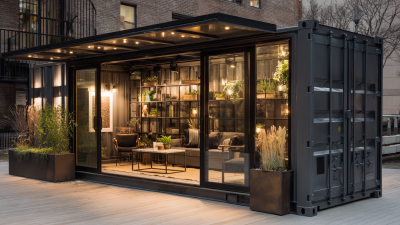Unlocking Savings: The Ultimate Guide to Discount Shipping Containers for Your Next Project
In today’s fast-paced world of construction and logistics, finding cost-effective solutions is essential for the success of any project. One of the most versatile and economical options available is the use of discount shipping containers. These containers not only provide a sturdy and secure means of storage but also serve as innovative building materials for a wide range of applications, from temporary housing to pop-up shops. As you embark on your next venture, leveraging discount shipping containers can help unlock significant savings while maintaining quality and functionality. In this ultimate guide, we will explore the best ways to source these containers, assess their suitability for various projects, and discover how they can be transformed to meet your specific needs—all while keeping your budget in check. Whether you are a seasoned developer or a DIY enthusiast, understanding how to effectively utilize discount shipping containers can elevate your project to new heights.

Understanding the Cost Benefits of Discount Shipping Containers
When considering cost-effective solutions for construction, storage, or mobile offices, discount shipping containers emerge as a top contender. According to a report by IBISWorld, the portable storage industry has grown by an impressive 4.2% annually over the past five years, emphasizing the rising popularity of these containers. The average cost of a used shipping container typically ranges from $1,500 to $3,000, a fraction of the expense associated with traditional building materials. This substantial gap offers individuals and businesses the opportunity to allocate funds toward other project areas, enhancing overall savings.
**Tip:** To maximize your savings, explore local suppliers and consider purchasing containers in bulk. Many companies provide significant discounts for multiple units, which can dramatically reduce the cost per container.
Beyond initial acquisition costs, shipping containers are notoriously durable and require minimal maintenance, translating to long-term savings. A container can last up to 25 years with proper care, making it a wise investment compared to conventional construction methods. As a result, the Total Cost of Ownership (TCO) can be significantly lower, with some studies suggesting a reduced lifetime cost by as much as 35%.
**Tip:** Be sure to thoroughly inspect used containers for structural integrity and any signs of damage. This diligence helps safeguard your investment while ensuring that you benefit fully from the potential cost advantages.
Unlocking Savings: The Ultimate Guide to Discount Shipping Containers for Your Next Project
| Container Size | Average Cost ($) | Discount Rate (%) | Estimated Savings ($) | Ideal Projects |
|---|---|---|---|---|
| 20 ft | 2,500 | 10 | 250 | Storage, Small Workshops |
| 40 ft | 4,500 | 15 | 675 | Site Offices, Mobile Retail |
| 40 ft High Cube | 5,000 | 12 | 600 | Storage, Workshops |
| 45 ft | 5,500 | 10 | 550 | Transport, Large Equipment Storage |
| 10 ft | 1,500 | 5 | 75 | Small Tools, Temporary Storage |
Identifying Reliable Sources for Affordable Shipping Containers
When embarking on a project that requires shipping containers, identifying reliable sources for affordable options is crucial. Begin your search by exploring local suppliers, as they often have better prices and can provide containers in good condition. Additionally, checking online marketplaces and auction sites can yield significant savings, but ensure to verify seller credibility through reviews and ratings before making a purchase.

Tips: Always ask for photos of the container before purchase to assess its condition and potential needed repairs. Also, consider negotiating the price, especially if you're purchasing multiple containers or additional services like delivery.
Networking within communities focused on modular space solutions can lead you to trustworthy suppliers. Joining forums or social media groups allows you to connect with others who have made similar purchases. They can share firsthand experiences and recommend sources that offer discounted rates, helping you make an informed decision while keeping your budget intact.
Comparing New vs. Used Shipping Containers for Budget Savings
When considering shipping containers for your next project, understanding the financial implications of choosing new versus used options is crucial. According to industry reports, the price for a new shipping container can range from $3,000 to $5,000, depending on size and condition. In contrast, used containers often come in at a significantly lower price, typically ranging from $1,500 to $3,000. This price differential can translate into substantial savings, particularly for budget-conscious projects or DIY enthusiasts.
However, it's essential to weigh the savings against the condition of the containers. A report by the Container Owners Association indicates that while used containers can provide a more affordable option, they may also come with wear and tear that could impact longevity and functionality. On average, a new container has a lifespan of 10 to 15 years, while a used container may only last 5 to 10 years depending on prior usage. In selecting the right container, it's crucial to align your project needs with your budget constraints, ensuring that cost savings do not compromise quality and suitability.
Creative Uses for Discount Shipping Containers in Various Projects
 Discount shipping containers are proving to be a versatile solution for numerous creative projects. Whether you're considering a unique home, a pop-up shop, or a cozy café, these containers can be easily repurposed to meet your vision. For example, many have turned shipping containers into stunning tiny homes, leveraging their durability and innovative design to create stylish living spaces that are both affordable and environmentally friendly.
Discount shipping containers are proving to be a versatile solution for numerous creative projects. Whether you're considering a unique home, a pop-up shop, or a cozy café, these containers can be easily repurposed to meet your vision. For example, many have turned shipping containers into stunning tiny homes, leveraging their durability and innovative design to create stylish living spaces that are both affordable and environmentally friendly.
Tips:
When planning your project, consider the layout and insulation needs of your container. Proper insulation is crucial, especially for residential projects, to ensure comfort in varying climates. Additionally, think about the container's location; a well-positioned container can enhance accessibility and visibility if it's intended for commercial use.
Beyond residential uses, shipping containers also lend themselves well to community projects, such as mobile markets or disaster relief shelters. Their modular nature allows for easy stacking and customization, making them an excellent choice for community-driven initiatives.
Tips:
Before embarking on a community project, check local regulations regarding shipping container use. Ensuring compliance can save you time and resources in the long run. Furthermore, collaborating with local artists or craftsmen can help transform the containers into vibrant hubs that reflect the spirit of the community.
Tips for Negotiating the Best Prices on Shipping Containers
When negotiating the best prices on discount shipping containers, it’s crucial to remain informed about current shipping trends and market conditions. Recent reports indicate a surge in container imports in the U.S., rising by 7% in April, which can create competitive pricing dynamics. Prospective buyers should leverage this increased supply to negotiate better rates, especially given the pressure on shipping companies due to high fuel costs and the potential impact of labor strikes affecting U.S. ports.
Additionally, understanding the broader economic context is essential. For instance, ongoing trade negotiations and tariff adjustments can influence pricing structures. With tariffs on certain imports potentially reaching as high as 245%, shipping container prices may fluctuate in response to these changes. Buyers should engage with multiple suppliers, discussing aspects like delivery timelines and volume discounts to maximize savings. By being strategic and well-informed, you can unlock significant savings for your next project involving shipping containers.




